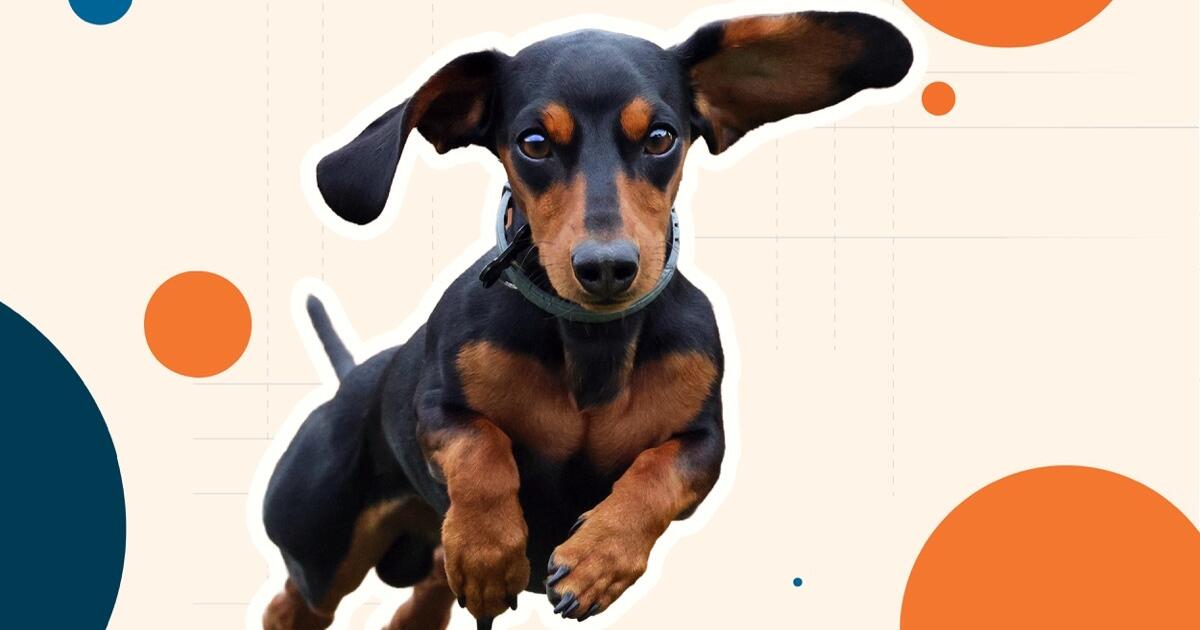Copyright Los Angeles Times

Breed Overview The Dachshund, famously known the world over as the wiener dog, is unmistakable with its alert and endearing nature. These former hunters are known for a loud bark, an excellent sense of smell and a very loyal nature. Dachshund History and Origins Badger Dog The word dachshund literally comes from the German word “Dachs” (badger) and “Hund” (dog), which perfectly reflects their original purpose. In Germany, badgers were (and are) tough, formidable animals. They live in complex underground burrows and have sharp claws and a nasty bite. To go after them, you needed a special kind of dog. In the Middle Ages, breeders needed a dog that was fearless, stubborn, and relentless. They had to hunt badgers by tracking them with their keen sense of smell, digging into the burrow, and then fighting the animal underground. Their long, low bodies were perfect for navigating tunnels. Their short, powerful legs were built for digging. And that surprisingly loud bark? That was to let the hunters above ground know where they were. This hound wasn’t just chasing rabbits; they were also bred to take on animals as tough as wild boar. Dachshund History The breed’s popularity in America grew in the late 19th and early 20th centuries. But this dachshund dog hit a rough patch during World War I and II. Because of the breed’s strong association with Germany, its popularity plummeted in Allied countries. They were even used in propaganda as symbols of the enemy. It was a tough time for the breed, but their charm and personality eventually won people back over. Hot Dog So where did the “wiener dog” and “sausage dog” names come from? The “wiener” part is pretty straightforward, short for “wienerwurst,” which is a sausage from Vienna (Wien), Austria. The hot dog (frankfurter) is from Frankfurt, Germany. This nickname really took off in America. The long-bodied pup was a perfect visual match for the popular food, and the name just stuck. It’s a key part of the inspired humor and charm that surrounds this iconic dog breed. Development of the Breed Breeders refined the dachshund over time, crossing the hound, terrier and spaniel lines. This created the smooth-, longhaired-, and wirehaired varieties known today, though all within the same breed. Over time, dachshunds gained popularity not just as hunting dogs but also because of their confident, outgoing personalities. They eventually became one of the most recognizable companion small dogs in the world. The Dachshund was even chosen as the first official mascot for the 1972 Summer Olympics in Munich. Size and Appearance Dachshunds come in two main sizes: standard and miniature. Standard dachshunds were built for serious hunting. The miniature dachshund was bred for smaller prey and compact living. They are available in three distinct coat type options—smooth, longhaired and wirehaired. Each has its own look and grooming needs. Dachshunds have a variety of colors and patterns, with red being the most common color. They come in many colors and patterns too, like dapple or brindle. Distinctive Features Regardless of size or coat, it’s the dachshund’s silhouette that is iconic: an elongated body, short sturdy legs with strong muscles, expressive eyes and long, floppy drop ears. Though we find it charming and somewhat humorous today, that signature shape was quite functional, allowing them to dig, burrow and maneuver underground. Temperament and Training Dachshunds are described by their owners as bold, clever and affectionate. They have big personalities in those compact bodies. They bond strongly with their family members and really love being involved in daily life. That same independence that made them great hunters, however, can translate into pure stubbornness, especially during dog training. Dachshunds have a loud bark and can be snappy if pampered too much. Training Tips Like most dogs, Dachshunds respond well to positive, consistent reward-based training and may become resistant with harsh corrections. Training sessions should be short, playful and engaging. These dogs love mental challenges. Socialization and Other Pets Dachshunds can be aggressive towards strangers and other dogs. They also have a strong prey drive meaning they may not be compatible with other pets in the house. Households with smaller animals should introduce them carefully and supervise interactions. How the Dachshund Dog Compares Dog Breed As a dog breed, the Dachshund is in a class of its own. The American Kennel Club (AKC) and other major kennel clubs place them in the hound group. This makes sense because of their powerful sense of smell and hunting background. But they’re not typical hounds. They also have a lot of terrier-like qualities—that stubbornness, bravery, and desire to dig. So, you’re getting a unique mix of hound and terrier in one small package. Other Breeds and Other Dogs How do they stack up against other breeds? Unlike many other dogs in the hound group (like Beagles or Basset Hounds), Dachshunds tend to be more “one-person” or “one-family” dogs. They are often suspicious of strangers and can be very vocal about it. Compared to a breed like a Golden Retriever, they are far more independent and less eager to please. This is why dog discipline and training are so important from day one. They need to understand the rules, or they will happily make their own. Puppies and Early Socialization A dachshund puppy thrives on interaction, structure and routine. Early exposure to new people, sounds, other dogs and environments helps them grow into confident adults. Their long backs and short legs are a vulnerability. Dachshund puppies should avoid jumping on and off furniture or climbing stairs until they are fully grown to prevent injuries. Dachshund Puppy Bringing home a dachshund puppy is an adventure. They are incredibly cute, smart, and playful. (This is true for smooth dachshunds, long haired, and wire haired pups alike). But that cute puppy will test you. This is where dog discipline comes in. Be consistent, firm, and positive. The most critical thing for a new owner to understand is their physical vulnerability. You must protect their backs. Those potential back injuries are the breed’s biggest health risk. This means teaching them not to jump on or off furniture is extremely important. Ramps are a fantastic investment. Protecting them from these specific health conditions starts the day you bring them home. Coat Type, Grooming and Care The Dachshund’s three coat type varieties—smooth, longhaired and wirehaired—each come with their own grooming routine. All are considered moderate shedders. Smooth-coated dachshunds are the easiest. They just need weekly brushing. Longhaired dachshunds need more frequent brushing to prevent tangles and matting. Wirehaired dachshunds may benefit from being occasionally hand stripped to maintain their coat texture. Routine Maintenance Routine grooming also includes nail trimming, ear cleaning and dental care. Their long ears and short stature mean owners should regularly check for dirt buildup and signs of ear infections. Ear infections are common in Dachshund dogs, so regular ear checks and cleaning are recommended. Health and Wellness Dachshunds tend to be healthy, but their unique build—that long spine and short legs—creates specific vulnerabilities. Intervertebral disc disease (IVDD), a form of disc damage, is one of the most common health conditions. About 20-25% of Dachshunds will develop IVDD during their lifetime. Dachshunds can have eye problems like cataracts, glaucoma, and progressive retinal atrophy. Idiopathic epilepsy can occur in Dachshunds, commonly starting between 1 and 5 years old. Dachshunds may develop patellar luxation, which is the dislocation of the kneecap. A luxating patella often occurs simultaneously in both hind legs of Dachshunds. Bottom line: maintaining a healthy weight and avoiding high-impact activities (like jumping from furniture) are key preventive measures for this condition. Common Health Conditions Other health conditions include patellar luxation, obesity and eye conditions. Regular veterinary checkups, a balanced diet and regular low-impact exercise can help reduce risks and extend quality of life. Fun Activities and Exercise Don’t let their size fool you. Dachshunds have plenty of energy and love to play. Daily walks, fetch sessions and short bursts of activity are ideal. These activities also help build stronger muscles. They also benefit from puzzle toys and games that engage their problem-solving instincts. Regular Exercise What does regular exercise look like for a Dachshund? The key is “low-impact.” Daily Walks: Brisk walks on a leash are perfect. This keeps their muscles strong (which supports their back) without a lot of jarring. Avoid: High-impact activities like jumping for a frisbee, intense running on hard surfaces, or roughhousing that involves twisting. Mental Exercise: Don’t forget their brains. Scent games and puzzle toys are just as important as physical exercise. Life Expectancy and Longevity The average life expectancy for Dachshunds is 12 to 16 years. Many can live well into their teens. Their longevity depends on genetics, weight management and lifestyle. Keeping them fit, mentally stimulated and well cared for contributes to a long, happy life. Adoption and Companion Considerations Dachshunds consistently rank among the world’s most popular breeds. They’re celebrated for their size, adaptability and personality. But they do best with owners who understand their physical needs and strong-willed temperament. The miniature smooth-coated Dachshund can be an ideal fit for families with children or those in smaller living spaces. Adoption and Breed-Specific Rescues If you’re convinced a Doxie is for you, adopting from a rescue is a fantastic option. Many wonderful dachshunds are looking for a second chance. These organizations specialize in the breed, so they understand their specific needs, health issues, and quirks. They’re experts at matching the right dog with the right home. Dachshund Rescue of North America An all-volunteer organization operating across the United States and Canada that rescues, rehabilitates and rehomes dachshunds and mixes. Coast to Coast Dachshund Rescue A national, non-profit organization dedicated to rescuing Dachshunds and Dachshund mixes from shelters and owner surrenders. Dachshund Rescue of Los Angeles A prominent rescue operating in Southern California, dedicated to reducing the number of dachshunds euthanized in local shelters by finding them educated and committed homes.



